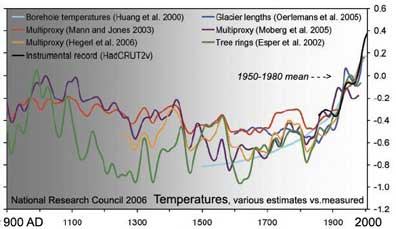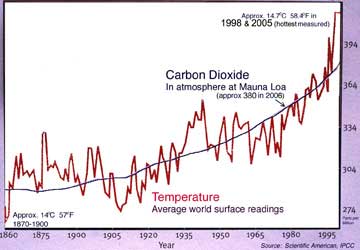
With this warning to an international science meeting in February 2004, David A. King, Chief Scientific Advisor to the British Government, brought the issue of global warming into sharp focus.
The World View of Global Warming project is documenting this change through science photography from the Arctic to Antarctica, from glaciers to the oceans, across all climate zones. Rapid climate change and its effects is fast becoming one of the prime events of the 21st century. It is real and it is accelerating across the globe. As the effects of this change combine with overpopulation and weather crises, climate disruptions will affect more people than does war.
The 2005 average global temperature equaled (within several hundredths of a degree) the record warm year of 1998, according to meteorologists. 2002-4 were nearly as warm, and the 11 warmest years on record have all occurred since 1990. In response, our planet has been changing with warming winds and rising seas. At the poles and in mountains, ice is under fire and glaciers are receding. Down into the temperate zone, change is rearranging the boundaries of life. The plants and animals with whom we share the planet are adapting and moving -- some even going extinct -- because they have no choice.
We six billion humans are being affected, too. Coastal towns are suffering from rising sea level, storms are getting stronger and 35,000 people died in European heat waves in 2003. However, we have choices to make to help correct and ameliorate global warming. This is a story of frightening scale and and great urgency that is just beginning to be told. Please go to Actions to see what you can do now.
I began photographing climate change in 1999, about when scientists started to realize how great a change in temperatures is taking place in our time. Past earth temperatures left their mark in tree rings, glaciers and ancient lake and ocean sediments, and the record shows slowly decreasing temperatures over the last 2000 years. In that time there have been warm and cool periods, but nothing like the rise in temperatures in the past 150 years -- and no increase even close to the past 30. This research has created what has become the single most powerful icon of climate change, the so-called "hockey-stick" graph of temperatures. In 2005-6 it was subjected to intense re-analysis. Evidence of previous cool and warm periods has increased, but the rapid and sustained heat gain especially since the 1970s remains unparalleled in recent earth history.
 In general global temperatures have risen since the 19th century industrial revolution. There is little scientific question the reason is a steep increase in atmospheric carbon dioxide -- CO2 -- from human use of fossil fuels. Methane, ozone, other gases and dusts have also increased greatly. The mechanism of our atmosphere is that gases like CO2 and methane trap some of the sun's radiation and hold it in the lower atmosphere, heating it. The natural greenhouse effect made the earth warm enough for life, but the effect is much higher now. Ice core records show that whenever CO2 has increased in the earth's past, so has temperature. The recent increase in atmospheric CO2 is 200 times as great as any previous change seen in the ice cores. The current level is 380 parts per million, the highest in more than 650,000 years. It shows no signs of decreasing.
In general global temperatures have risen since the 19th century industrial revolution. There is little scientific question the reason is a steep increase in atmospheric carbon dioxide -- CO2 -- from human use of fossil fuels. Methane, ozone, other gases and dusts have also increased greatly. The mechanism of our atmosphere is that gases like CO2 and methane trap some of the sun's radiation and hold it in the lower atmosphere, heating it. The natural greenhouse effect made the earth warm enough for life, but the effect is much higher now. Ice core records show that whenever CO2 has increased in the earth's past, so has temperature. The recent increase in atmospheric CO2 is 200 times as great as any previous change seen in the ice cores. The current level is 380 parts per million, the highest in more than 650,000 years. It shows no signs of decreasing.
 This increase caused earth's average atmospheric temperature to go up about 1. degree F in the 20th century. Now, according to NOAA, the global warming rate in the last 25 years has risen to 3.6 degrees F per century. This tends to confirm the predictions of temperature increases made by international panels of climate scientists (IPCC). The ocean has actually absorbed most of the added CO2 and heat -- becoming warmer and very slightly more acidic. These increases, seemingly small, have a giant effect on weather, climate zones, plants and animals, sea life, glaciers and river flow -- and thus human life. My project and this Web site seek to document these changes. For more on past climate and today's weather, see especially the Paleoclimate and Weather sections.
This increase caused earth's average atmospheric temperature to go up about 1. degree F in the 20th century. Now, according to NOAA, the global warming rate in the last 25 years has risen to 3.6 degrees F per century. This tends to confirm the predictions of temperature increases made by international panels of climate scientists (IPCC). The ocean has actually absorbed most of the added CO2 and heat -- becoming warmer and very slightly more acidic. These increases, seemingly small, have a giant effect on weather, climate zones, plants and animals, sea life, glaciers and river flow -- and thus human life. My project and this Web site seek to document these changes. For more on past climate and today's weather, see especially the Paleoclimate and Weather sections.


Tidak ada komentar:
Posting Komentar